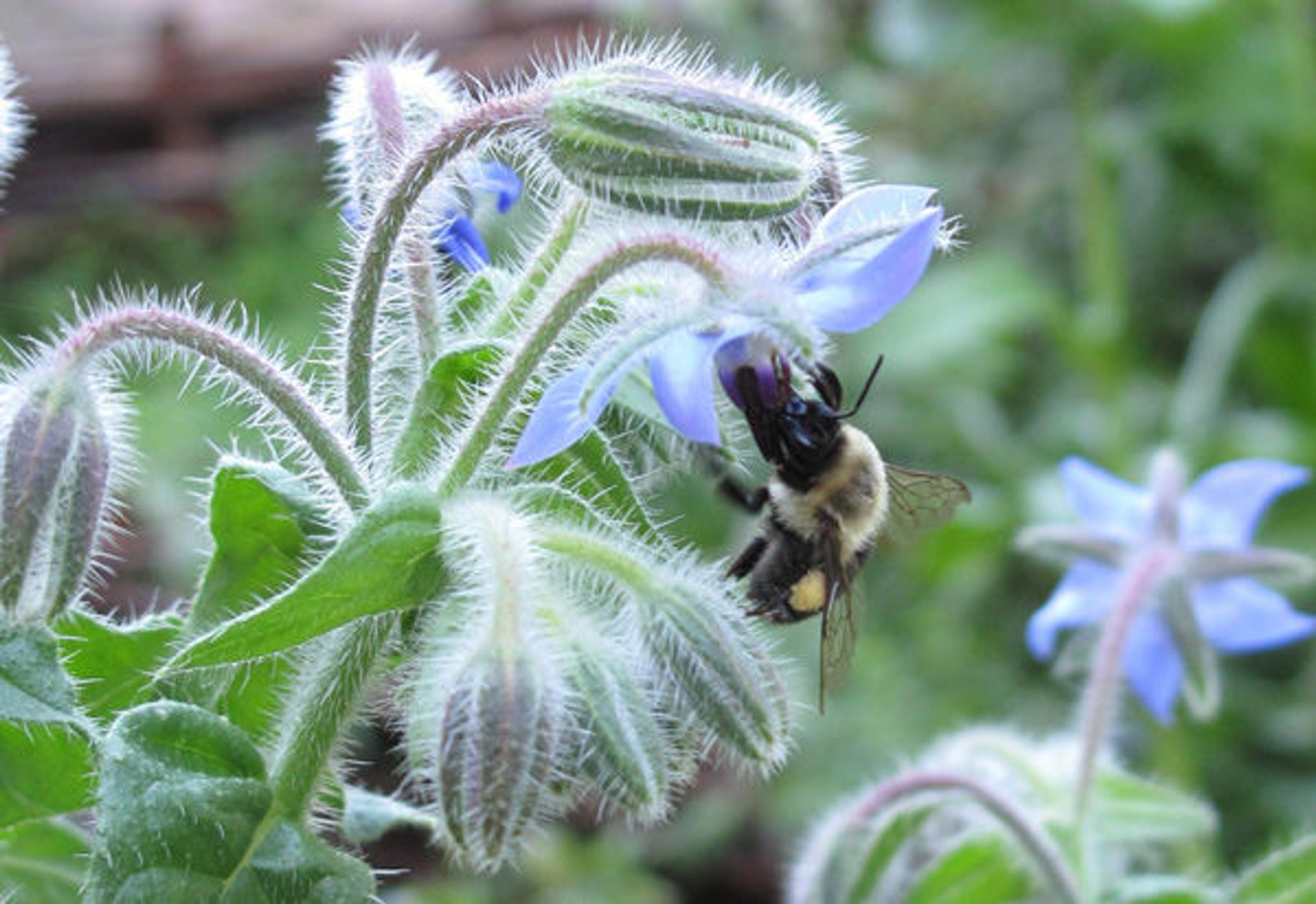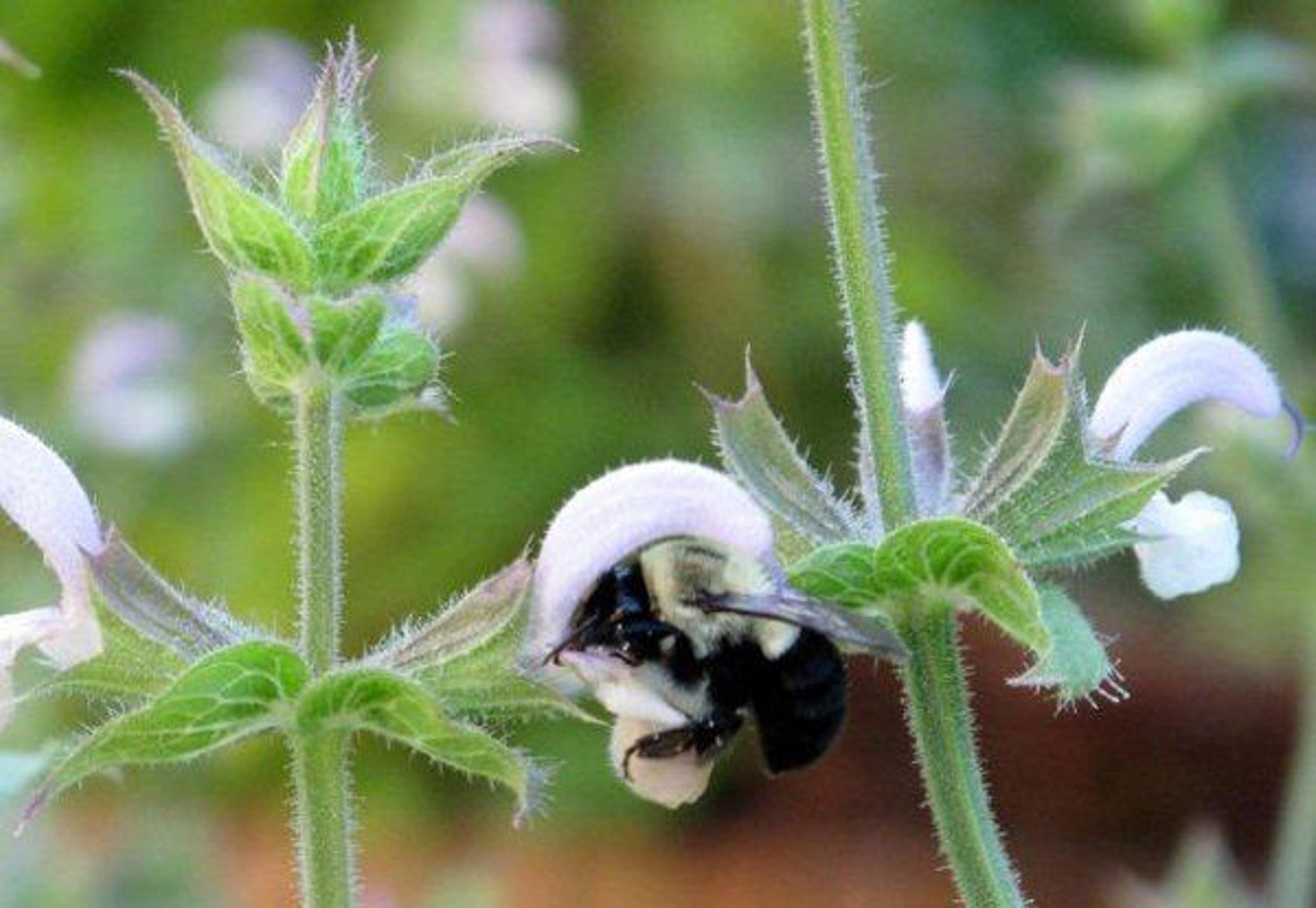
A bee devours the medieval borage flower (Borago officinalis), grown in Bonnefont Herb Garden. Notice the golden pollen basket attached to its body; female bees have special hairs on their legs and bodies for carrying pollen. Photograph by Carly Still
«"The honey bee (apis) is from the heat of the sun. It loves the summer, has a swift heat, and is unable to endure cold…" —Hildegard von Bingen»
Medieval naturalists and commoners were well aware of the great benefits of bees, as these insects provided them with both honey and beeswax. Honey was a common sweetening agent long before sugar was available, and was used to preserve fruit, cure hams, flavor wine, make mead, and cook all sorts of things. Honey was also used to treat various health ailments and was said to "…[cleanse] the chest and the stomach; it purges the abdomen, it keeps the humours of the flesh and the mouth from decaying. It heats the blood…it should have a pure fragrance and be thick with a slightly reddish color" (Spencer, 26). Beeswax was equally important; it was used in candle making, as a furniture polish, and for metal casting. It may also have been the first chewing gum (Hartley, 164).
Interestingly enough, medieval naturalists classified the behaviors and habits of bees with those of birds, not insects, but much like today, the specialized skills of a bee master, or beekeeper, were highly regarded (Collins, 74).

The fragrant clary sage (Salvia sclarea) is adored by bees. Clary sage is grown in the medicinal bed in Bonnefont Herb Garden. Photograph by Carly Still
The honey bee (Apis mellifera) is probably the most widely known pollinator, and of course, producer of honey. Seen throughout North America, this busy, social bee is actually a Eurasian and African species. European settlers enjoyed the honey bees' delicious honey so much that they brought them to America, where they are now at home (Shepherd, 111).
Visitors are often in awe of the healthy bee populations in the gardens of The Cloisters, and are curious to know if we keep bees on site. We do not, though beehives were prevalent throughout the medieval landscape and may have been constructed out of willow and "weather-proof finish by wool and moss packing, and clay daub (exactly like the wattle and daub construction of their bee master's own hut)" (Hartley, 165). Hives were thought to be best situated above ground level, near flowers, and protected from wind, rain, and pests (Collins, 74). Nonetheless, our bee residents and their crucial role in pollination are clearly evident and are fun for visitors and staff to observe.
The calamint (Calamintha nepeta, "White Cloud") in Cuxa Cloister garden explodes with bee activity. Calamint, a fragrant type of mint with a beautiful white cloud of flowers, is incredibly attractive to bees. Video by Andrew Winslow
A bumblebee enjoys the beautiful globe thistle (Echinops ritro, "Veitch's Blue") growing in Cuxa Cloister garden. In the United States, there are close to four thousand different native bee species ranging in size, color, and social habit. Video by Andrew Winslow
Sources
Collins, Marie, and Virginia Davis. A Medieval Book of Seasons. New York: Harper Collins, 1992.
Hartley, Dorothy. Lost Country Life. New York: Pantheon Books, 1979.
Spencer, Judith, trans. The Four Seasons of the House of Cerruti. New York: Facts on File, 1984.
Throop, Priscilla, trans. Hildegard von Bingen's Physica: The Complete English Translation of Her Classic Work on Health and Healing. Rochester, VT: Healing Arts Press, 1998.
Shepherd, Matthew, Stephen L. Buchmann, Mace Vaughan, Scott Hoffman Black. Pollinator Conservation Handbook. Portland, Oregon: The Xerces Society, 2003.